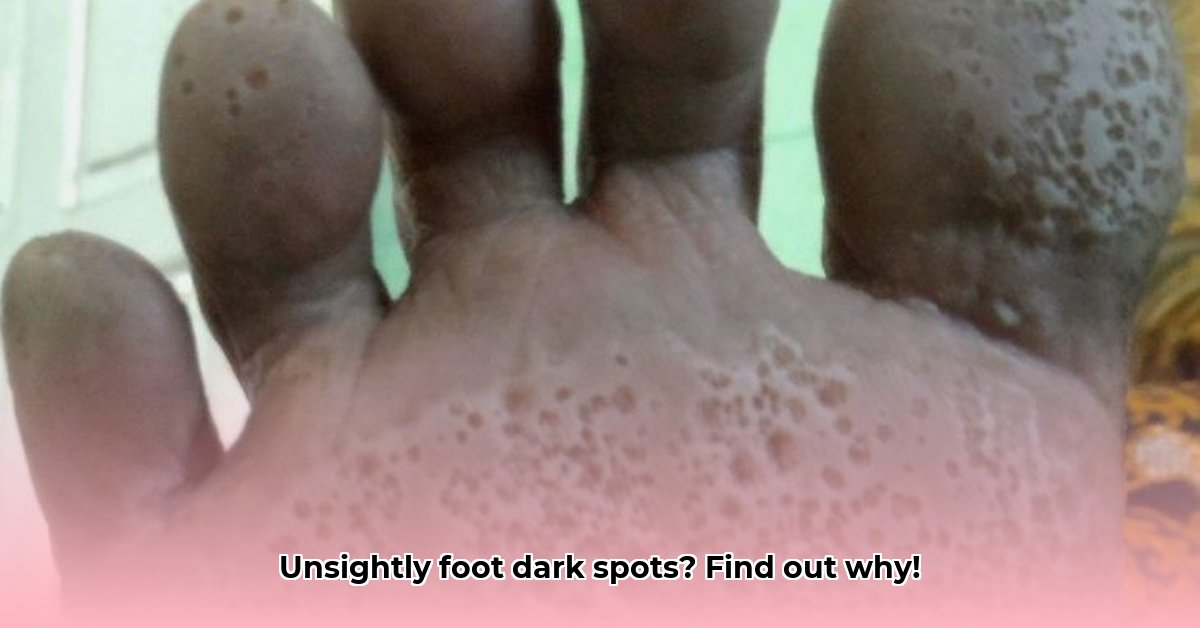# Dark Spots on Feet: Causes, Diagnosis & Treatment
<p>Ever noticed those dark spots on the soles of your feet? Most of the time, they're nothing to worry about, but sometimes they can indicate an underlying issue. This guide helps you understand what might be the cause of those spots and what you can do about them. We'll explore various reasons for their appearance, ranging from simple infections to more serious skin conditions. We'll also discuss how healthcare providers diagnose these spots and outline the best treatment approaches, ensuring you receive the appropriate care and maintain healthy feet.</p>
For ingrown toenail issues, [learn more about removal costs](https://chaztin.com/cost-to-remove-ingrown-nail/).
## Decoding Dark Spots on the Bottom of Feet: Understanding Causes and Concerns
Have you ever looked down and noticed a mysterious dark spot on the bottom of your foot? It's a common occurrence. These spots can stem from a multitude of factors, some entirely harmless, others requiring a healthcare provider's evaluation. Let's unravel the mystery together and learn the **primary causes of dark spots on feet**.
### The Usual Suspects: Common and Harmless Dark Spots
Often, dark spots on your feet are benign and related to everyday factors. For example, compromised circulation in your legs can lead to discoloration known as venous stasis dermatitis (skin changes due to poor blood flow). Imagine it as congestion in your leg's veins; blood flow slows down, potentially darkening your skin. This is more common with age and may present with swelling and itchiness. Simple measures such as elevating your feet, wearing comfortable compression socks, and incorporating more exercise can provide relief.
Another common cause is plantar warts (warts on the soles of the feet). These small growths result from a common virus and can be painful. You might observe small, dark spots inside the wart. Over-the-counter treatments containing salicylic acid (a peeling agent) can be effective. These medications gradually remove the wart. If over-the-counter options don't suffice, a healthcare provider can employ cryotherapy (freezing) or other removal techniques.
Consider tinea nigra (a fungal infection), which manifests as flat, brownish or black patches, typically on the soles of the feet. This infection thrives in warm, humid conditions. An antifungal cream is usually effective. If you've noticed a slow-growing, discolored, asymptomatic spot, this fungal infection is a likely possibility.
### When to Seek Medical Advice: Recognizing Serious Concerns
While many dark spots are not a cause for concern, some warrant prompt medical evaluation. Malignant melanoma (a serious type of skin cancer) can sometimes appear as a dark, asymmetrical spot. Unlike harmless spots, melanoma may exhibit rapid changes in size, shape, or color and may feel different from the surrounding skin. If you observe something suspicious, consult a healthcare provider immediately. Early detection significantly improves treatment outcomes. The American Academy of Dermatology reports a 99% survival rate for melanoma detected and treated before it spreads.
### Exploring Other Possibilities: A Broader Perspective
Various other conditions can contribute to dark spots on your feet. Individuals with diabetes may develop dark, painless spots (diabetic dermopathy). Injury or trauma, such as a foreign object embedded in the skin or a bruise (purpura), can also result in darkened areas. Calluses, those areas of thickened skin, can trap dirt, resulting in a darker appearance.
### A Personalized Approach: Getting a Diagnosis and Treatment
Determining the underlying cause of your dark spots is the first step. A dermatologist or podiatrist will conduct a thorough examination of your feet, inquire about your medical history, and discuss your lifestyle. They might use a dermatoscope – a specialized magnifying instrument – for a closer inspection. In certain instances, a small tissue sample (biopsy) may be necessary to rule out melanoma or other serious conditions. Treatment is tailored to the specific cause, encompassing simple home remedies for fungal infections, surgical intervention for melanoma, or management of circulation problems.
### Taking Charge: Prevention and Self-Care Strategies
Preventing all causes of dark spots may not be feasible, but you can reduce your risk. Maintaining good foot hygiene is essential – keep your feet clean and dry. Choose well-fitting shoes that protect your feet from injury. If you have circulation issues, partner with your healthcare provider for management strategies. Regular self-examination of your feet for any new or changing spots is also crucial. If you notice any concerning changes – a growing spot, color changes, irregular borders, or pain – seek medical advice promptly.
### Your Action Plan: Straightforward Steps for Foot Health
Here's a practical checklist to guide you in maintaining informed and proactive foot care:
1. **Regular Self-Checks:** Examine your feet regularly for any new or changing spots. Integrate this into your routine.
2. **Seek Prompt Medical Help:** Don't delay seeking medical attention if you observe anything worrisome.
3. **Maintain Excellent Foot Hygiene:** Keep your feet clean and dry to minimize infection risk.
4. **Wear Appropriate Footwear:** Protect your feet from friction and potential injury.
5. **Manage Circulation Issues:** If you have circulation problems, collaborate with your healthcare provider to improve your blood flow.
**Important Note:** This information is for general knowledge and should not replace professional medical advice. Always consult a qualified healthcare professional for diagnosis and treatment of any medical condition.
## Deciphering Dark Spots: How to Differentiate Between Benign and Malignant Dark Spots on Feet
**Key Takeaways:**
* Melanoma on the feet can be challenging to identify because its appearance varies and doesn't always align with commonly seen images.
* Early detection significantly improves the effectiveness of treatment for foot melanoma.
* Regular self-exams are paramount, particularly if you possess risk factors.
Have you ever spotted a dark spot on the bottom of your foot and wondered about its significance? It's a valid concern. Dark spots, or pigmented lesions, on the feet can arise from various causes, ranging from harmless sun exposure to more serious conditions. Understanding **how to differentiate between benign and malignant dark spots on feet** is therefore essential.
### Distinguishing Harmless Spots: Understanding Benign Dark Spots
Many dark spots on the feet are benign. These can be caused by:
* **Friction or Pressure:** Repetitive rubbing or pressure from footwear can induce hyperpigmentation (darkening of the skin). Calluses are a prime example.
* **Sun Exposure:** While less exposed compared to other body parts, your feet are still susceptible to sun damage, potentially leading to age spots.
* **Hormonal Changes:** Pregnancy or other hormonal fluctuations can sometimes result in dark patches on the skin.
* **Certain Medications:** Some drugs can induce hyperpigmentation as a side effect.
These benign spots generally exhibit regular borders, uniform color, and relatively small size. They rarely undergo significant changes in size or appearance. However, it's wise to seek professional evaluation if you have any concerns.
### Identifying Potential Risks: Recognizing Potentially Malignant Lesions
In contrast to benign spots, melanoma on the feet can be subtle and more dangerous. It often deviates from the classic ABCDEs of melanoma detection (Asymmetry, Border irregularity, Color variation, Diameter greater than 6mm, Evolving). Foot melanomas often present atypically, potentially leading to delayed diagnosis.
Key features to consider include:
* **Unusually Dark Spots:** A newly developed dark spot, particularly one significantly darker than your baseline skin tone, warrants evaluation.
* **Irregular Borders:** Fuzzy or poorly defined edges are a warning sign.
* **Uneven Color:** Variations in shading within the spot—light, dark, or even bluish hues—require attention.
* **Rapid Growth:** Any relatively quick growth or change in shape indicates need for medical evaluation.
* **Bleeding or Crusting:** Bleeding or scabbing originating from a dark spot is a cause for concern.
### A Step-by-Step Approach: How to Differentiate: A Practical Guide
Effectively **differentiating between benign and malignant dark spots on feet** necessitates both self-monitoring and professional assessment:
1. **Regular Self-Exams:** Routinely examine your feet, ideally monthly. Use a mirror or enlist a family member's help to visualize difficult-to-see areas.
2. **Note Changes:** Pay attention to any new spots or changes in size, shape, color, or texture of existing spots.
3. **Professional Consultation:** If you notice any concerning changes, consult a dermatologist or qualified healthcare provider promptly.
### Examining Tools: Diagnostic Tools
Healthcare providers employ diagnostic tools, including:
* **Visual Examination:** The healthcare provider typically conducts a comprehensive visual assessment as a first step.
* **Dermoscopy:** This non-invasive technique utilizes a special magnifying lens to examine skin lesions, enhancing visibility of features not discernible to the naked eye.
* **Biopsy:** When suspicion arises, a small tissue sample (biopsy) is obtained for microscopic analysis.
Latest posts by Chaztin Shu (see all)
- Mini Bento Boxes For Packing Kids Snacks And Small Meals - December 27, 2025
- Small Bento Box Makes Packing Lunch Easy and Fun Again - December 26, 2025
- Adult Bento Box Lunch Ideas For Quick Healthy Portable Options - December 25, 2025










